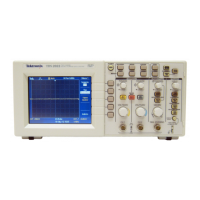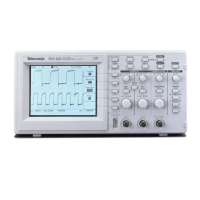Command Descriptions
TDS200, TDS1000/2000, TDS1000B/2000B, TPS2000 Programmer
2-85
CURVe?
<Block> is the waveform data in binary format. The waveform is
formatted as: #<x><yyy><data> where <x> is the number of
characters in <yyy>. For example, if <yyy> = 500, then <x> = 3,
where <yyy> is the num ber of bytes to transfer. Refer to Block
Arguments on page 2--13 for more information.
If width is 1, then all bytes on the bus are single data points. If width
is 2, then all bytes on the bus are 2-byte pairs. Use the DATa:WIDth
command to set the width. <data> is the curve data.
<asc curve> is the waveform data in ASCII format. The format for
ASCII data is <NR1>[,<NR1>...] where each <NR1> represents a
data point.
CURVe?
Might return the following ASCII data:
:CURVE 13,6,3,2,–1,–9,–14,–19,–29,–35,–67,–1,–78,–62,
–50,–31,–27,–7,0,12,29,39,45,43,41,47,41,38,33,26
DATa, WFMPre
DATa
Sets or queries the format and location of the waveform data that is
transferred with the CURVe command. Since DATa:DESTination and
DATa:TARget are equiva lent, only DATa:DESTination is returned by
the DATa? query.
Waveform
DATa { INIT }
Arguments
Examples
Related Commands
Group
Syntax

